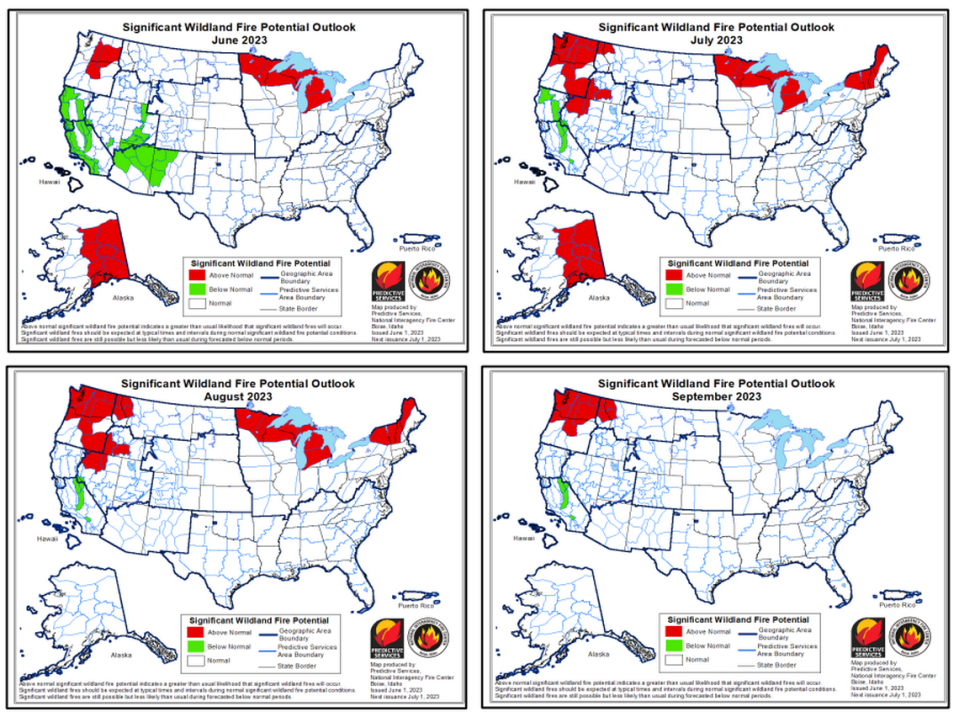Red flag fire and wind warning issued for much of Central Washington and Tri-Cities
Wildfire danger is high in much of southeastern Washington and south into Oregon because of the strong winds forecast through 11 p.m. Tuesday, according to the National Weather Service.
A wind advisory is issued for a 250-mile stretch of Central Washington and Central Oregon from Chelan, Wash., south to Fossil, Ore., including the Tri-Cities.
There also is a red flag fire warning from Connell south to Pendleton and from Yakima east to Walla Walla.
The Tri-Cities can expect wind gusts as high as 32 mph Tuesday evening, with sustained wind speeds up to 22 mph.
Adding to the fire danger is expected high temperatures near 93 degrees, dry vegetation and low relative humidity, creating critical fire conditions, according to the weather service. Relative humidity is in the 20% range.
That means any fires that start will spread rapidly, it said.
Do not burn outdoors and be cautious about driving through tall grass, the agency warned.

The wind is thanks to a cold front sweeping across the Tri-Cities area, which also will bring cooler temperatures.
A high of 79 is forecast Wednesday with continuing gusty winds and then highs in the 80s through Saturday, followed by highs in the mid to low 70s forecast for Sunday and the Monday Juneteenth holiday.
Mostly sunny weather is predicted during the daytime hours through Monday.
Washington fire season forecast
The red flag warning comes as Washington state is expected to have a worse fire season than normal this summer through September.
In Eastern Washington, including the east Cascade Mountains, the above normal potential for significant wildfires starts this month.
But by July nearly all of the state, with the exception of parts of Garfield and Asotin counties in the southeast corner Washington, will have an above normal potential for significant wildfires, according to the National Interagency Fire Center.
A warmer than normal late spring, with a warmer than usual summer forecast is to blame, according to the fire center.

As of June 1, the amount of water in the snowpack in the East Cascade Mountains feeding the Yakima Basin was just 19% of average, own from 99% of average at the start of the month, because of warmer than normal temperatures.
The Bureau of Reclamation said those with the oldest, or senior, water rights should get 100% of their entitlements, but holders of newer, junior water rights would likely get about 77%.
Over half of the water rights in the Basin are held by junior water rights holders, or those with claims after May 1905.
The Kennewick Irrigation District is grouped with junior water right holders, but it gets the irrigation water that returns to the Yakima River between the Parker Gauge downriver from Union Gap and Prosser Dam.
Historically, it has gotten somewhat more water than the percentage available for holders of junior water rights.
WA senator priority
Late last week, Sen. Maria Cantwell, D-Wash., discussed the Washington state fire season outlook at a Senate Energy and Natural Resources Committing hearing with Jaelith Hall-Rivera, a deputy chief for the Forest Service.
“My whole state is in the forecast for this summer being in the epicenter of this ... there are small fires already burning in Central Washington,” Cantwell said.
An above normal risk is not typical for the historically cooler and wetter Western Washington, her staff pointed out.
Past years with forecasts such as the one for the upcoming fire season in Washington state have been followed by especially destructive fire seasons, Cantwell’s staff said.
Cantwell called for improving coordination between agencies that help fight wildfires to ensure faster fire response.
As wildfires become more frequent and intense in the West, Cantwell has made resources to prevent, prepare, fight and recover from major fires a priority.
At an April, Senate hearing she called on the Forest Service to hire more firefighters for the 2023 fire season.
The Bipartisan Infrastructure Law included $3.4 billion for wildfire risk reduction, $1 .1 billion to reduce hazardous fire fuel and $500 million for rehabilitation of burned areas.
She also helped secure an additional $1.8 billion for the Forest Service program to reduce hazardous fuels as part of the Inflation Reduction Act.
Cantwell also has introduced the Fire Ready National Act to improve the National Oceanic and Atmospheric Administration’s wildfire response and forecasting.
